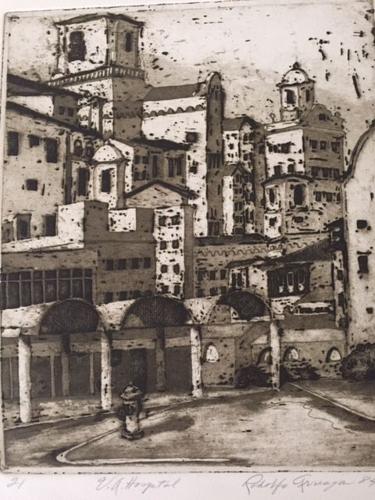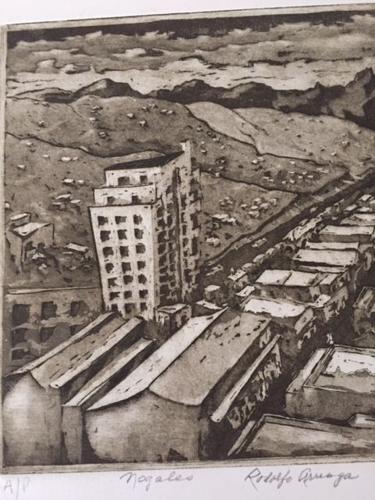In 1975, Rodolfo Arriaga, a Tucson firefighter for about 20 years, was in a serious car accident. During his recovery he reignited his love of art.
Arriaga healed, retired from the Tucson Fire Department in 1982, and a year later earned a bachelor’s degree in fine arts from the University of Arizona. He was 53 years old.
Then he went to work. Primarily creating etchings, Arriaga recreated scenes from the beloved downtown barrio where he was born. He also etched churches in towns and cities where he and his wife traveled. He created still-life images, captured buildings and did a self-portrait.
His artwork flowed with his passion and imagination.
“He didn’t do it for money,” said his widow, Brunilda Arriaga. “He loved it.”
Arriaga passed away in 2014 at the age of 84, and left a trove of works. Others are in homes in Tucson and other U.S. cities.
Some of his works will be on display and auctioned Friday, April 15, at the Sosa Carrillo Frémont House, 151 S. Granada Ave. The event is sponsored by Los Descendientes del Presidio de Tucsón and the Arizona Historical Society.
Rudy, as he was known to his family and friends, was a humble and quiet man who loved to dance with his wife, and was a hard worker. While he worked as a firefighter, he operated a commercial arts and sign painting business at their midtown home on Silver Street, near Salpointe Catholic High School, where the Arriagas raised their three children, Carlos Arriaga, Celina Gallagher and Leticia Arriaga-Shrank. In his later years he worked for Sunnyside Unified School District.
Among Arriaga’s clients were Tucson International Airport and political candidates, including the late governor Raúl H. Castro and former U.S. Sen. Dennis DeConcini, said Brunilda Arriaga.
“He always had two jobs,” said his widow.
His work ethic started when he was a kid, growing up in the barrio and later on the small family ranch on the far north side of town.
Arriaga was born on West 17th Street near North Main Avenue. He was the youngest of six children born to Roberto and Josefina Arriaga. Several years later the Arriaga family lived on small acreage and farmed the land between the Santa Cruz River and the railroad tracks.
When he was about 8 years old, Arriaga went to work at Choice Market, one of many Chinese-owned corner markets dotting the old downtown barrio. He learned some Chinese.
He also learned to love Tucson and made lifelong friends, Brunilda said.
In 1949 he graduated from Tucson High School and not long after joined the U.S. Marine Corps. He went to war in Korea with Easy Company, a local reserve unit made up mostly of Mexican-American young men. In Korea, Arriaga fought in the Battle of the Chosin Reservoir in 1950.
He returned to Tucson in 1951 and began courting his future wife, who was a student at the old nursing school at St. Mary’s Hospital on the west side. They had met before he shipped off.
“He chased me,” said Brunilda, who met Rudy when he showed up at the hospital with a minor injury. They weren’t able to date because the hospital nuns did not permit the students to date patients, she added.
While he was away at war, Arriaga wrote numerous letters to his favorite nursing student, who had gone to Los Angeles to further her studies. She still has those letters.
And she has much more. In the time since his passing, Brunilda has found letters from his former clients, including from elected officials, and artwork in the garage where he worked, and in the house. Recently she found a surprising letter from the UA: his acceptance to the master’s program in the School of Fine Arts.
“I didn’t expect all that,” said Brunilda.
The family is beyond pleased that they continue to discover reminders of a husband, father and grandfather. He continues to give and reveal his talent and passion. Their memories of a softspoken man are refreshed.
His renderings of the barrio are special to the family. It was where he would return to visit old friends, said his daughter, Celina Gallagher.
“He loved the whole culture of the barrio,” she said. “We always went back to look and to reminisce.”






